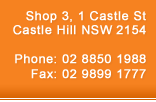Baulkham Hills is located 31km north-west of Sydney, off Windsor Road.
There are several versions of how this high area between Castle Hill and Parramatta was named. The most likely is its resemblance to the pastoral border country of Roxourgh, between Scotland and England, which bears a similar name, Buckholm Hills. This was home to one of the early settlers, Andrew Mcdougall. Mcdougall, who arrived in Sydney in 1798 from Roxbourgh, was one of the several settlers to receive grants in the area in 1799. He called his 150 acre grant Roxbourgh Hall. The estate remained in the family until 1876, and Roxbourgh was built in 1960. Mcdougall was one of the trustees appointed when 3,000 acres were set aside as Baulkham Hills Common in 1804. Whatever its origin, the name has officially been recognised since 1802.
The oldest farm house in the area is Joyce Farmhouse in Valerie Cresent, near Seven Hills. It was built in 1804 by William Joyce, destroyed by fire and rebuilt in 1806, and used as an inn between 1811 and 1826. Joyce had received his 30 acre grant in about 1794.
One of the oldest pioneer families in Parramatta came into this area when George Suttor received a grant of 186 acres in 1802. He settled in the property, which he called Chelsea Farm, after his birthplace in London. Here he planted the first orange trees in the district and became a prominent orchardist. He later received another grant, in Bathurst, and the Suttor family moved to the plains beyond the Blue Mountains, but Suttor continued to hold the Chelsea Farm until his death in 1859. The main house, Chelsea Farm, was built in 1873 by one of his grandsons.
In 1856, an official post office was opened in Baulkham Hills, followed by the first ever school in 1868.
Parramatta's increasing population affected Baulkham Hills as more settlers spread into the district to plant orchards in the area's ideal conditions. By 1890, residents were clamouring for better means of transport. As a result of many official discussions, a steam tramline was opened in 1902 to carry passengers from Parramatta Station to Baulkham Hills. The route was carried along Church Street, over the Lennox Bridge and along Windsor Road, to its destination 5 miles away. The tramline was changed to a railway connected to Westmead on 28th January 1923, but the line closed in February 1932.

